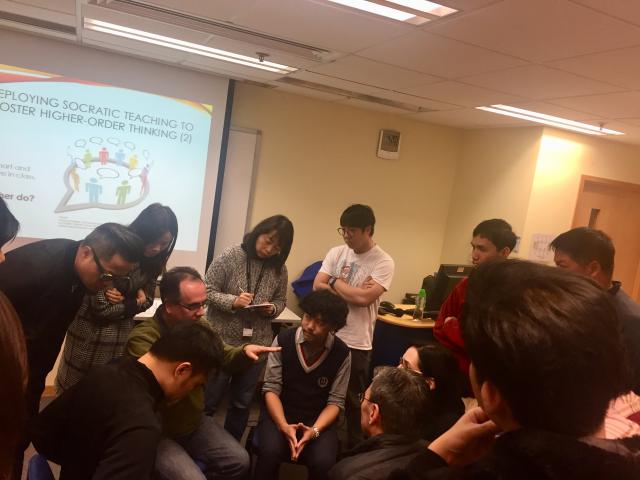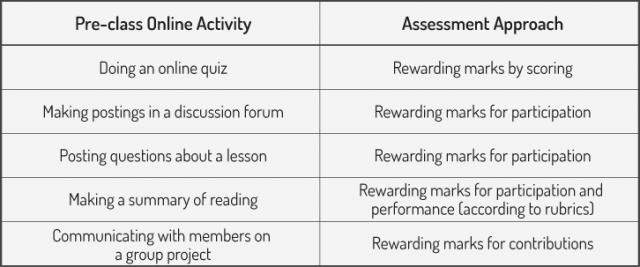如何改善學生在混合式學習中的參與度
混合式學習主張結合網上學習和面授來促進學與教。由於混合式學習近年成為一個熱門的教學話題,所以教學中心於本年一月邀請了容艷琼博士在「混合式學習:創造不一樣的學生參與」工作坊中,與我們分享她在混合式學習方面的專業知識和經驗。
確保高效的課前參與
是次工作坊重點是透過網上學習活動和課堂學習的設計,提升學生個人及團體的參與度,從而建立高層次思維能力。課前活動的目的是讓學生先汲取該課節的基本知識或資訊,為課堂學習作準備。雖然課前的網上活動種類繁多,比如觀看視頻、閱讀課文資料和總結閱讀等,但教師經常遇到的一個難題就是學生不參與課前網上活動。
容博士分享與不參與網上活動的學生溝通的小貼士。教師可以巧妙地問學生「是否遇到什麼技術上的問題?」而避免「你有沒有......?」或「你為什麼不......?」這類問題。學生大多能意會到教師善意的提示,回去進行網上練習。除此之外,更重要的是在網上活動設計中加入激勵性的點子。教師不妨考慮使用一些遊戲化的元素和設計,如進度尺、獎勵徽章和積分。這不僅可以提高學生的參與度,而且可以顯示他們的進度和成績。
評估學生學習表現
關於評估學生在課前活動中的表現,容博士對不同類型的網上活動評估方式有以下建議:

利用蘇格拉底式的教學促進學生混合式學習
教師可以按學生在網上活動的得分、參與度和貢獻幾種表現給予分數。然而,參與並不等同貢獻。根據Dennis Gioia (1987)的說法,「參與意味著參與其中,分享和純粹參加」,而貢獻則意味著更多的「投放智力、分享知識和建構知識」。教師可能會問,學生做什麼才算是對課堂討論有貢獻呢?學生作出總結、通過整合概念和討論而提出建議,或提出值得進一步討論的問題均屬貢獻。
教師怎樣將課前網上活動與面授教學聯繫起來?容博士提出以蘇格拉底式教學吸引學生參與混合式學習。學生可以在課前先進行與課堂討論相關的網上活動,然後在課堂上與同學討論。蘇格拉底式的教學方法是「需要合作性的論證對話,詢問和回答批判性的問題,並找出潛在的假設」(Murray, n.d.)。在工作坊中,參與者圍成內外圈就座,來體驗蘇格拉底式的教學過程。外圈的成員為內圈的討論提供批判性分析。這種座位安排的優點是讓內圈的成員先獨立思考問題。當他們再與外圈的成員形成一組後,會受到他人的想法刺激,如容博士所言「如果不能改變概念,就改變他們的想法」。在這個過程中,教師(或促導者)沒有給予答案,只作有限的指導。相反,參與者思考、創造、參與,從而對該主題有更深入的理解。蘇格拉底式的教學除了提高學生對課堂的參與外,更有助高層次思考。

蘇格拉底研討會的形式 (圖像由教學中心提供,2018)

參與者在工作坊中體驗了蘇格拉底式的教學法。(相片由教學中心提供,2018)
混合式學習不只是一個流行的術語,它更應該反映出以學生為中心的教學觀念。透過適當的課前網上學習活動和課堂活動設計,教師可以提高學生的參與度和學習成效。
參考文獻:
Gioia, D. A. (1987). Contribution!, Not Participation in the OB Classroom. Organizational Behavior Teaching Review, 11(4), 15-20.
Murray, J. (n.d.) Teaching Strategies About the Socratic Method. Retrieved on February 13, 2018, from http://www.teachhub.com/teaching-strategies-about-socratic-method
How to Make a Difference in Student Engagement with Blended Learning Approach
Blended learning suggests the combination of online learning and face-to-face instruction to facilitate learning and teaching. As blended learning has become one of the hottest pedagogical terms over the recent decade, Centre for Learning and Teaching (CLT) invited Dr Paula Hodgson to share with our teachers her expertise and experience in blended learning in the workshop of “Make a Difference in Student Engagement with Blended Learning Approach” in January 2018.
Ensuring Effective Pre-class Engagement
The workshop focused on the design of online and in-class learning tasks to get students engaged individually and in teams to build the capability of higher-order thinking. The purpose of the pre-class activities is to enable students to obtain the key foundation knowledge or information of which they will further look into in class. There could be a variety of pre-class online activities, such as watching videos, reading course materials and making a summary of reading. One of the challenges teachers often encounter is that students are not participating in the pre-class online activities.
Dr Hodgson gave us tips on communicating with students who did not participate in the online activities. Teachers may take a subtle approach by asking students questions like, “Were there any technical problems?” instead of “Have you…?”, “Why didn't you…?” Usually students could pick up these friendly hints and go back to their online exercises. On top of the reminder, it is more important to incorporate some motivating elements in the design of online activities. Teachers could consider using some gamified elements and designs, such as progress bar and rewarding badges and points, which not only improve students' engagement, but also show their progress and achievement of the level of completion.
Evaluating Performance
Concerning the evaluation of student performance in pre-class activities, Dr Hodgson recommended the following assessment approaches to different online activities:

Marks can be rewarded to students in terms of scoring, participation and contribution in different assigned online tasks. However, there are differences between participation and contribution. According to Dennis Gioia (1987), “participation connotes involvement, sharing and simply taking part” while contribution suggests more “intellectual involvement and sharing of knowledge and knowledge construction.” Teachers may ask what students do are considered as making contributions to class discussion. It is when students provide summaries, make suggestions by integrating concepts and discussions, or ask questions that lead to further discussion.
Deploying Socratic Teaching to Engage Students in Blended Learning
What can teachers do to link the pre-class online activities with the face-to-face contact in the classroom? Dr Hodgson presented the adapted Socratic teaching approach, which advocates pre-class online activities to be followed by an in-class activity, to engage students in the blended learning. The Socratic method of teaching “requires cooperative argumentative dialogue between individuals, asking and answering questions that stimulate critical thinking, and draw out underlying presumptions” (Murray, n.d.). In the workshop, participants experienced the process of Socratic teaching by forming a fishbowl setting. Members from the outer circle provide critical analysis for discussion in the inner circle. The advantage of this setting is to allow members in the inner circle to think individually first. When they form a group with members from the outer circle, they would be stimulated, as in Dr Hodgson's words, “change their mindset if not the concept”. In this process, the teacher (or the facilitator) does not give answer but minimal guidance. On the contrary, the participants think, create, participate, and generate a deeper understanding of the topic. On top of enhancing students' engagement in the in-class activity, the Socrative teaching also encourages higher-order thinking.

Setting of a Socratic Seminar (Image courtesy of CLT, 2018)

Participants experience the Socractive teaching approach in the workshop. (Photo courtesy of CLT, 2018)
Blended learning is not just a popular term, it should reflect the long standing view of student-centred approach in learning and teaching. Through the design of the appropriate pre-class online and in-class activities, students' engagement and effectiveness of learning would be enhanced.
References:
Gioia, D. A. (1987). Contribution!, not participation in the OB classroom. Organizational Behavior Teaching Review, 11(4), 15-20.
Murray, J. (n.d.). Teaching Strategies About the Socratic Method. Retrieved on February 13, 2018, from http://www.teachhub.com/teaching-strategies-about-socratic-method
